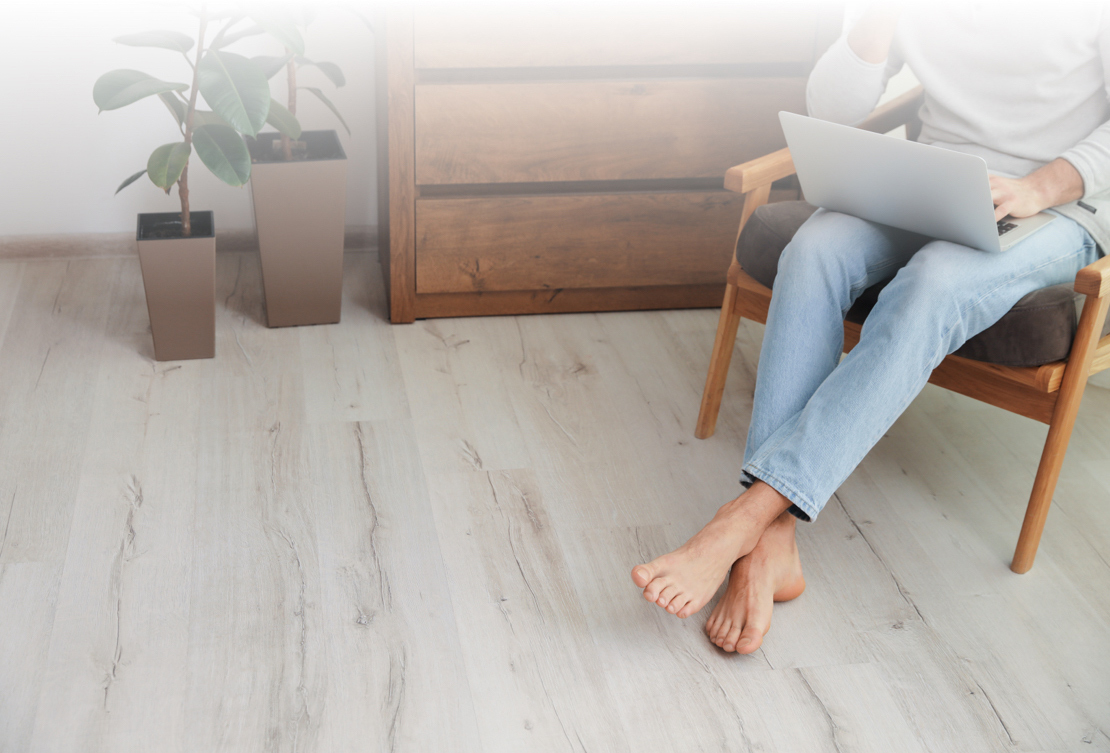For checking the flatness, refer to the current standardization. To do this, place a measuring rod or straightedge on the high points of the surface. How to determine the gauge at the deepest point in relation to the bearing surfaces (measuring point distances). With a measuring point distance of 180 cm, a vertical deviation of maximum 3 mm may be present. Larger deviations should be compensated for by appropriate measures – e.g. by using self-leveling fillers.
The test is carried out with the CM device, whereby the following limit values must not be exceeded:
- For cement screeds ≤ 2 CM % – heating screeds < 1.8 CM %
- For calcium sulfate screeds/calcium sulfate flowing screeds ≤ 0.5 CM % – Heating screeds ≤ 0.3 CM %.
- Planks with 0.1 mm wear layer: Use class 21
- Planks with 0.3 mm wear layer: Use class 23/31
- Planks with 0.5 mm wear layer: Use class 33/42
Residential – areas intended for private use
- 21 moderate / low: areas of low or intermittent use, bedrooms.
- 22 normal / medium: areas with medium use Living rooms, entrance corridors
- 23 strong: areas of intensive use living rooms, entrance halls, dining rooms and corridors.
Commercial – areas intended for public and commercial use.
- 31 moderate: areas with low or intermittent use hotels, bedrooms, conference rooms, small offices
- 32 normal: areas with medium traffic classrooms, small offices, hotels, boutiques
- 33 strong: areas with heavy traffic corridors, department stores, lobbies, schools, open-plan offices
- 34 very strong: areas with intensive use multi-purpose halls, counter rooms, department stores
Industrial – areas intended for use by light industry.
- 41 moderate: areas where work is primarily sedentary and where light vehicles are occasionally used. Electronics workshops, precision mechanics workshops
- 42 normal: areas where the work is performed mainly standing and/or with vehicle traffic. Storage rooms, electronics workshops
- 43 strong: Other industrial areas Warehouses, production halls
As a general rule, the contractor for floor covering work or the private person laying the floor covering himself must, within the scope of his duty of inspection and due diligence, satisfy himself prior to laying that the substrate is ready for laying. When assessing the readiness for installation of these floors, the following points in particular must be taken into account. In the event of non-compliance, all warranty and guarantee claims shall lapse.
These values apply to screeds without admixtures. When admixtures are used and for fast-drying screeds, the measurements and limit values specified by the respective manufacturer must be observed. The test material must be taken from the lower third of the screed. The screed thickness must be measured and documented.
Our vinyl planks belong to group T
2.1 Classification of resilient floor coverings
2.1.1 EN 649, Classification of homogeneous and heterogeneous PVC floor coverings
The first step is to determine (Table 1) which wear group the floor covering belongs to.
| Table 1 | ||||||
| Wear group | T | P | M | F | ||
| Thickness loss | mm | EN 660-1 | ≤ 0,08 | ≤ 0,15 | ≤ 0,30 | ≤ 0,60 |
| Volume loss | mm³ | EN 660-1 | ≤ 2,0 | ≤ 4,0 | ≤ 7,5 | ≤ 15,0 |
Floor coverings with a transparent wear layer automatically belong – without testing – to wear group T!
The thermal resistance of our vinyl planks (5 mm) according to EN 12664 / EN12524 is 0.067 m2-K/W
Rth = ∆T / Qv
∆T = temperature difference
Qv = heat flow
λ = l / (Rth – A)
The unit of thermal resistance is K/W (Kelvin / Watt)
Advantage calculation with “thermal resistance”:
The values of the individual soil structure layers can be added together!
Underfloor heating: The sum of the values of all floor coverings should not exceed 0.15 m2-K/W
The floor only curls when the floorboards heat up and cannot compensate for each other! This may be due to the following reasons:
- The floorboards were laid cold.
- The planks are exposed to direct sunlight and stretch.
- The planks are illuminated by powerful spotlights or spotlights and thus heated (e.g. showrooms).
- In the subfloor there are shrinkage joints (e.g. in the cement screed) which are covered with floorboards.
Click connection dishes! This may be due to the following reasons:
- The floorboards were not carefully locked but knocked in.
- The click groove was dirty when locking.
- The floorboards have warmed up a lot and can not equalize.
- In the subfloor there are shrinkage joints (e.g. in the cement screed) which are covered with floorboards.
- The underlay mat is too soft and too thick. Planks are pressed in, bowl and unlock.
No, electric underfloor heating systems are classified as substrates with limited suitability. This is because a number of foil-based electric heating systems can produce surface temperatures well in excess of 28 °C. Approval is given for an electrically operated floor heating system: If this can be controlled digitally and it is ensured that the surface temperature never exceeds 28 °C. In addition, technical approval must be granted by the manufacturer of the heating for design floors. There is NO warranty claim for products installed on infrared floor heating.
Unfortunately, it is not possible to produce vinyl completely odorless. According to the DIN EN 16000 guidelines, these odors must subside after 28 days to such an extent that they are no longer disturbing.
These odorants are not harmful. According to the TÜV test report according to DIN EN 16000 of the French VOC regulation, our floorboards are confirmed to be approved in the best class A+ for residential use.
No. Depending on the product line, areas up to 400 m² can be laid in one piece. In doors we recommend to separate in any case. Room areas interrupted by pillars, partition walls, doorways or similar should be protected by placing movement joints of at least. 5 mm should be separated at the height of the components.
| Result [mg/m3] | Class | ||
| Formaldehyde | 5 | A+ | < 10 |
| Acetaldehyde | 10 | A+ | < 200 |
| Toluene | 16 | A+ | < 300 |
| Tetrachloroethene | n.d. | A+ | < 250 |
| Xylene | n.d. | A+ | < 200 |
| 1,2,4- trimethylbenzenes | n.d. | A+ | < 1000 |
| 1,4- Dichlorobenzene | n.d. | A+ | < 60 |
| Ethylbenzene | n.d. | A+ | < 750 |
| 2-Butoxyethanol | n.d. | A+ | < 1000 |
| Styrene | n.d. | A+ | < 250 |
| TVOC | 37 | A+ | < 1000 |
Yes, but the following must be taken into account. Underfloor heating must be at least 13 mm in the subfloor, NO electric heating mats. The surface temperature must not exceed 28 °C
Recommended tools: universal knife and straightedge, tape measure, 8 – 10 mm spacers, pencil, tapping block, rubber mallet, carpenter’s square, tie rod.
Check the floor in advance: Check the floor for defects right at the beginning. This way, you avoid misplacing defective goods and continue to receive your warranty.
Acclimatize the floor: Store your new floor before installation, at least 48 hours in the room to be installed. This allows the flooring to adapt to the temperature.
Note the subfloor: You may only install b!design floors on solid and non-floating subfloors. So that your new floor lasts a long time.
Have the appropriate tools ready: To ideally install your floor, use the tools recommended above.
Consider fixed objects: Fixed objects such as kitchen islands must not be fixed to your new flooring. Mount them directly on the substrate. Also maintain an expansion gap of at least 8 to 10 millimeters.
Comply with the installation instructions: For the correct installation of your new dream floor, the manufacturer’s installation instructions are binding and must be followed.
Maintain distance: Work with spacers. So that you keep the right distance from the wall. In addition, your floor will then not only lie straight, but also can not slip during installation.
Do not forget impact sound insulation: If your floor does not contain integrated impact sound insulation, you should definitely buy the recommended insulation to go with it. Because a carpet is not allowed insulation.
According to the applicable standards, the defects must be visible from a height of approx. 1.80 m (eye level) with light vertically from above or behind at approx. 2.40 m in front of the shoe tips, so that a complaint can be made. Defects which are only visible when kneeling against the light cannot be objected to!
According to the test report, the maximum personal charge for our vinyl planks is 1.84 kV. According to EN 1815, the maximum charge must not exceed 2 kV for the floor to still be listed as “antistatic”. Thus, the floor is antistatic.
Caution: Lower values are required in particularly sensitive applications (operating rooms, production rooms for electronic components, etc.).
A carpet pad for a design floor for clicking must be pressure-resistant in any case, as the subfloor must always be hard and firm. For the necessary acoustic comfort, we recommend the specially developed underlay mat for the b!design floors. This not only has excellent sound reduction values of approx. 18 dB, but also compensates for small unevennesses and additionally stabilizes the click connection. It is not suitable for products that already have an integrated underlay mat.
B!DESIGN LVT/SPC 1.5 22648264
Click locks only open when the planks cool down! This may be due to the following reasons:
- The click connections were not locked cleanly – no “click”! (only pressed in/were dirty)
- The click connections were damaged (smashed) during locking!
- The planks have warmed up a lot and cupped (e.g. sunlight) – this has unlocked the click groove – when they cool down, they open!
- The planks were installed warm in summer – cool down and are blocked by heavy objects, sticking putty joints, planks in door frames, etc.!
- The underlay mat is too soft and too thick! Planks are pressed in, bowl and unlock.
According to EN 649 and EN 651, the tolerance for PVC flooring is 0.2 mm, therefore only higher overhangs or wider gaps can be objected to.
Our design floors are equipped with a hard-wearing surface protection at the factory. Please use only a suitable cleaner approved for PU-finished floor coverings.
The residential conservatory is a conservatory intended for year-round use as a living space and thus also for use at comfort temperatures (more than 19 °C). This means that the temperature must not fall below 15 °C even in winter. Solar heating in summer is limited by natural shading and/ or constructive measures such as ventilation, suitable glazing and solar shading according to local conditions and orientation in order to avoid excessive temperature fluctuations of the ground. The room climatic conditions must be observed:
- Climate during installation: Room air temperature should be 20 °C (minimum 15 °C), relative humidity between 35% and 60%.
- Permanent living climate: room air temperature between 18 °C and 22 °C, relative humidity between 35 % and 60 % The surface temperature of the floor must not exceed 32 °C for vinyl/susify and 60 °C for SPC floor coverings. Installation can only take place on a substrate that complies with the specifications of DIN 18356 “Parquet Flooring” and DIN 18365 “Floor Covering Work”.
- The structure is permanently protected against rising moisture from the ground.
- The substructure is insulated in such a way that damage due to temperature differences or condensation is excluded.
In the case of screeds, the residual moisture values must be checked by means of a CM meter before laying and must be complied with:
- Cementitious screed heated/unheated: 1.8 CM% / 2.0 CM%.
- Calcium sulfate screed heated/unheated: 0.5 CM% / 0.5 CM%.
The substrate must be checked to ensure that it is ready for laying. In particular, this must be level, dry, non-slip, clean, free of cracks, free of release agents and resistant to tension and compression. If a leveling compound is applied to the substrate, the prescribed room climatic conditions, the required substrate preparation (sanding, priming, …) and the drying times must be strictly observed here. Before opening, the packages must acclimatize. To do this, store them unopened and lying flat on the floor for about 48 hours (in winter about 3 – 4 days) in the middle of the room where you want to install. In the case of full-surface bonding, the manufacturer-specific specifications (room climatic conditions, open time, sufficient adhesive quantity of the suitable adhesive) must be observed. The light fastness of our floors is tested according to test standard EN ISO 105-B02 and meets the highest requirements. Nevertheless, color changes due to strong and sustained high solar radiation cannot be ruled out. The product-specific installation instructions must be observed.
Before, during and after laying the following conditions should be met:
- a room air temperature of at least 18 °C
- a floor surface temperature of at least 15 °C
- a relative humidity between 35% – 60%.
The maximum surface temperature of 60 °C for SPC floors and 32 °C for vinyl/ECO floors must not be exceeded. In addition, a very fast heating process must be avoided.






















